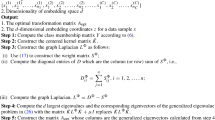Abstract
Data mining technology emerges as the times require. Through the integrated learning of data, the original data is transformed into a form suitable for operation, useful data is extracted for mining, and finally, various strategies of data mining are applied to generate useful patterns and rules. Multiplicative regression has the potential of small computation, stable algorithm, easy to understand results, and maximum potential for mining data, which can be widely used in small-sample data mining. Aiming at the high-dimensional and low-sample problem, this paper constructs a small-sample mining algorithm using partial least squares (PLS) model and realizes dimension reduction and classification learning under the unified framework of PLS and in the classification of gene expression spectrum (colon) cancer data. To realize the mining and visualization of small-sample data by PLS. Compared with the classical algorithm SVMs, the results verify the validity and reliability of the PLS algorithm for high-dimensional and low-sample data mining problems.




Similar content being viewed by others
Change history
04 October 2022
This article has been retracted. Please see the Retraction Notice for more detail: https://doi.org/10.1007/s11227-022-04856-y
References
Shen L, Xing Y, Qiudan LU et al (2018) Exploration of the meridian differentiation law in polycystic ovarian syndrome of hirsutism based on data mining technology. Chin Acupunct Moxib 38(2):165–173
Liu H, Zhao CY, Zhang W et al (2018) Study on medication laws of Tibetan medicine in treatment of plateau disease based on data mining technology. Zhongguo Zhong yao za zhi = Zhongguo zhongyao zazhi = China J Chin Materia Medica 43(8):1726
Jin Y, Cao J, Wang Y et al (2016) Ensemble based extreme learning machine for cross-modality face matching. Multimed Tools Appl 75(19):11831–11846
Bossi L, Bertino E, Hussain SR (2017) A system for profiling and monitoring database access patterns by application programs for anomaly detection. IEEE Trans Softw Eng 43(5):415–431
Hou S (2016) Development of diagnostic models for canine osteoarthritis based on serum and joint fluid mid-infrared spectral data using five different discrimination and classification methods. J Chemom 30(11):663–681
Chen Miaochao, Shengqi Lu, Liu Qilin (2018) Global regularity for a 2D model of electro-kinetic fluid in a bounded domain. Acta Math Appl Sinica English Series 34(2):398–403
Laumer S, Maier C, Eckhardt A (2015) The impact of business process management and applicant tracking systems on recruiting process performance: an empirical study. J Bus Econ 85(4):421–453
Ravikanth L, Jayas DS, White NDG et al (2017) Extraction of spectral information from hyperspectral data and application of hyperspectral imaging for food and agricultural products. Food Bioprocess Technol 10(1):1–33
Krallinger M, Leitner F, Valencia A (2010) Analysis of biological processes and diseases using text mining approaches. Methods Mol Biol 593:341
Altaf-Ul-Amin M, Afendi FM, Kiboi SK, Kanaya S (2014) Systems biology in the context of big data and networks. Biomed Res Int 2014:428570. https://doi.org/10.1155/2014/428570
Chen MC, Kong XS, Chen K (2014) Application of statistical analysis software in food scientific modeling. Adv J Food Sci Technol 6(10):1143–1146
Chen MC, Liu QL (2016) Blow-up criteria of smooth solutions to a 3D model of electro-kinetic fluids in a bounded domain. Electron J Differ Equ 128:1–8
Eshaghzadeh TM, Mitreva M, Gopalakrishnan V (2016) Application of taxonomic modeling to microbiota data mining for detection of helminth infection in global populations. Data (Basel) 1(3):19. https://doi.org/10.3390/data1030019
Hoang VD (2014) Wavelet-based spectral analysis. TrAC Trends Anal Chem 62:144–153
Krause D, Holtz C, Gastl M, Hussein MA, Becker T (2015) NIR and PLS discriminant analysis for predicting the processability of malt during lautering. Eur Food Res Technol 240(4):831–846
Author information
Authors and Affiliations
Corresponding author
Additional information
Publisher's Note
Springer Nature remains neutral with regard to jurisdictional claims in published maps and institutional affiliations.
This article has been retracted. Please see the retraction notice for more detail:https://doi.org/10.1007/s11227-022-04856-y
Rights and permissions
Springer Nature or its licensor holds exclusive rights to this article under a publishing agreement with the author(s) or other rightsholder(s); author self-archiving of the accepted manuscript version of this article is solely governed by the terms of such publishing agreement and applicable law.
About this article
Cite this article
Hu, J., Fang, J., Du, Y. et al. RETRACTED ARTICLE: Application of PLS algorithm in discriminant analysis in multidimensional data mining. J Supercomput 75, 6004–6020 (2019). https://doi.org/10.1007/s11227-019-02900-y
Published:
Issue Date:
DOI: https://doi.org/10.1007/s11227-019-02900-y




